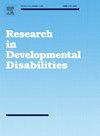智障学生学校安置轨迹的差异
IF 2.6
2区 医学
Q1 EDUCATION, SPECIAL
引用次数: 0
摘要
背景和目的智障学生通常需要广泛的支持。与有其他特殊教育需要的学生相比,他们更经常被安置在单独的环境中,如特殊学校。虽然学校安排是为了满足个人需求,但它们也可能导致教育差异。本研究考察了有心理障碍学生的安置轨迹。方法我们对3227名至少在一学年接受特殊教育强化支持的学生进行了长达11年的跟踪调查,分析了这些学生的纵向数据。18 %有行政ID标签,反映学生的主要教育支持需求。使用多项逻辑回归,我们比较了学校安置和没有ID标签的学生之间的安置转移数量。性别和第一语言被纳入评估额外的差异。结果具有ID标签的学生比具有其他类型SEN的学生更有可能参加单独的设置,这一趋势随着年龄的增长而增加。男学生和以德语为第一语言的学生通常在不同的环境中接受教育。男学生转学的几率也更高。结论本研究突出了具有ID标签的学生与具有其他类型sen的学生在学校安置轨迹上的差异,未来的研究应探索影响安置决策的因素,包括环境和学生特征。本文章由计算机程序翻译,如有差异,请以英文原文为准。
Disparities in the school placement trajectories of students with intellectual disabilities
Background and objectives
Students with intellectual disabilities (ID) often require extensive support. They are more frequently placed in separate settings, such as special schools, than students with other special educational needs (SEN). Although school placements are intended to meet individual needs, they may also contribute to educational disparities. This study examines the placement trajectories of students with ID.
Methods
We analysed longitudinal data from 3227 students who received intensive SEN support in at least one school year by tracking their placements over 11 years. 18 % had an administrative ID label reflecting the student’s primary educational support need. Using multinomial logistic regressions, we compared school placements and the number of placement transfers between students with and without the ID label. Sex and first language were included to assess for additional disparities.
Results
Students with the ID label were more likely to attend separate settings than those with other types of SEN, a trend that increased with age. Male students and those for whom German was their first language were more often schooled in separate settings. Male students also had higher odds of placement transfers.
Conclusions
This study highlights differences in school placement trajectories between students with the ID label and those with other types of SEN. Future research should explore the factors that influence placement decisions, including environmental and student characteristics.
求助全文
通过发布文献求助,成功后即可免费获取论文全文。
去求助
来源期刊

Research in Developmental Disabilities
Multiple-
CiteScore
5.50
自引率
6.50%
发文量
178
期刊介绍:
Research In Developmental Disabilities is aimed at publishing original research of an interdisciplinary nature that has a direct bearing on the remediation of problems associated with developmental disabilities. Manuscripts will be solicited throughout the world. Articles will be primarily empirical studies, although an occasional position paper or review will be accepted. The aim of the journal will be to publish articles on all aspects of research with the developmentally disabled, with any methodologically sound approach being acceptable.
 求助内容:
求助内容: 应助结果提醒方式:
应助结果提醒方式:


